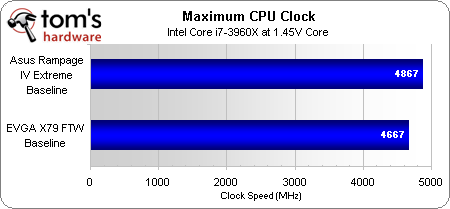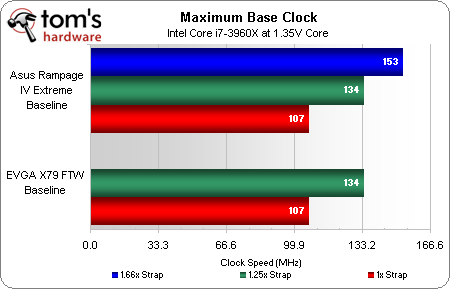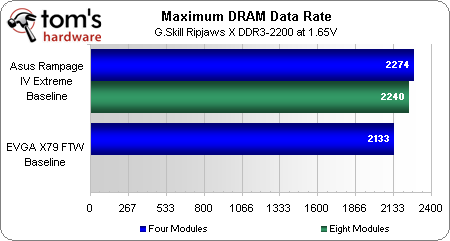Overclocking: Asus Rampage IV Extreme Versus EVGA X79 FTW
Many companies claim to offer the best overclocking for your money, yet only two compete for the best overclocking at the very highest price point. Today we put those claims to the test, including a full set of benchmarks to analyze performance gains.
Breaking Boundaries
| BIOS Frequency and Voltage settings (for overclocking) | ||
|---|---|---|
| Row 0 - Cell 0 | Asus Rampage IV Extreme | EVGA X79 FTW 151-SE-E777-KR |
| Base Clock | 80-300 MHz (0.1 MHz) | 85-287.5 MHz (1 MHz) |
| CPU Multiplier | 12x to 57x (1x) | 0x to 60x (1x) |
| DRAM Data Rates | 800-2666 (266.6 MHz) | 1067-2400 (266.6 MHz) |
| CPU Vcore | 0.80-2.10 V (5 mV) | 0.90-1.99 V (1 mV) |
| CPU VCCSA | 0.80-1.70 V (5 mV) | 0.90-1.99 V (1 mV) |
| VTT Voltage | 1.05-1.70 V (6.25 mV) | 0.90-1.55 V (1 mV) |
| X79 PCH Voltage | 0.80-1.60 V (6.25 mV) | 0.71-2.59 V (40 mV) |
| DRAM Voltage | 1.20-2.1 V (5 mV) | 0.90-1.99 V (1 mV) |
| CAS Latency | 3-15 Cycles | 3-15 Cycles |
| tRCD | 4-15 Cycles | 3-15 Cycles |
| tRP | 4-15 Cycles | 3-15 Cycles |
| tRAS | 4-40 Cycles | 9-63 Cycles |
While we attempted to use identical base clocks for our overclocking benchmarks, those weren’t necessarily the absolute overclocking limits of this processor. We found that by adding just a few hundred kilohertz to the base clock, the Rampage IV Extreme was capable of pushing an extra 67 MHz behind its highest 100 MHz BCLK result.
EVGA gained nothing, tolerating not even the tiniest increase beyond the 4.67 GHz previously found in our 133.3 MHz base clock attempts. The same stability limit could be reached at 101.5 MHz base clock by using a 46x multiplier.
Our processor doesn’t work well at the chipset's 1.66x strap, with Asus’ 153 MHz max representing an underclock of some components. Anything less than 153 MHz was too much of an underclock for those components (likely the PCIe and/or SATA controllers), and the X79 FTW couldn’t successfully fit the processor within the narrow frequency range that allowed this strap.
Experienced hands are required to reach DDR3-2133 on the X79 FTW, since its default timings weren’t stable using XMP values. We couldn’t use its 21.33x multiplier anyway, and this overclock required both manual timing configuration and a 133 MHz base clock.
Get Tom's Hardware's best news and in-depth reviews, straight to your inbox.
Current page: Breaking Boundaries
Prev Page Overclocking Stability Compared Next Page Test Setup And Benchmarks


